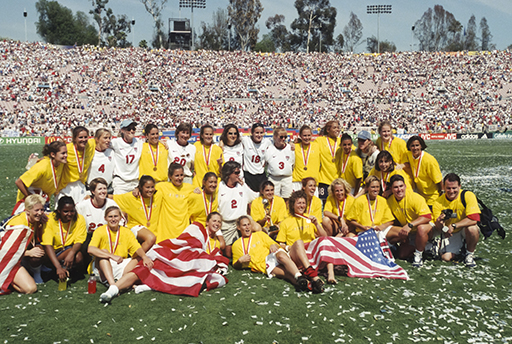5 USA vs China PR: an iconic image emerges
United States vs China PR (1999 women’s final)
The background:
The original plan had been for the third women’s World Cup to be hosted in a selection of considerably smaller grounds across the US’s east coast, but the US’s Olympic victory three years earlier generated serious interest in the sport (FIFA, 2019). The event organising committee saw clear value in the commercial aspect of the tournament and sought to capitalise on this by securing several larger stadiums to house the matches (Longman, 1999). This was an interesting development considering how FIFA had previous displayed limited interest in the women’s tournament, only retrospectively awarding the 1991 tournament World Cup status after it was originally called ‘The FIFA Women’s World Championship for The M&Ms Cup’ (Glendenning, 2019a), due to Mars’ (maker of M&M confectionary) sponsorship of the competition.
The 1999 final came just weeks after a US-led NATO bombing on the Chinese embassy in Belgrade, killing three Chinese journalists and injuring a further twenty people, sparking anti-US demonstrations across China. Despite the US government’s claim that the attack was an accident, US-China tensions escalated.
The match:
90,185 spectators, including President Clinton, attended the World Cup final. The match ended in a 5-4 penalty shootout victory for the home nation. In the six seconds it took for her jubilant teammates to sprint from the halfway line to swarm her, Brandi Chastain found the time to remove her shirt and swing it about her head in triumph. In her black sports bra, Chastain sank to her knees and raised both fists in triumph. The match and the iconic image of Chastain’s celebration placed women’s football firmly into the public’s consciousness.

The aftermath: The match has since been considered a defining moment in the history of women’s sport (Brownell, 2015). FIFA later called the action of the US organisers to switch matches to larger stadia a ‘gamble that paid off’ (FIFA, 2019).
Activity 4 A breakthrough in the women’s game
Watch the video clip below and identify how the 1999 World Cup provided a breakthrough for the women’s game. Try to consider this from a political perspective in terms of status and power.
1999 women’s World Cup: A breakthrough in the women’s game [Tip: hold Ctrl and click a link to open it in a new tab. (Hide tip)]
Discussion
The 1999 World Cup epitomised the growing reach of women’s football since the first World Cup eight years previously; though, as outlined in Session 4, this is not to suggest that developments in women’s football were quick and straightforward. The clip might be a little generous in suggesting that the superstar status of the likes of Mia Hamm meant that following 1999 women’s football had stars to rival the men’s game. However, it did ensure that females around the world suddenly had new role models. The Chinese team returned home as heroes but their success in reaching the final has not been repeated. However, China’s national sporting profile soared in the aftermath with a successful Beijing’s 2008 Olympic bid, as well as hosting rights for the 2003 women’s World Cup (awarded but later moved to USA following a severe SARS outbreak).
Chastain’s celebration has been claimed as the ‘most iconic photograph ever taken of a female athlete’ (Longman, 2019). While China PR forward Sun Wen, recipient of both the tournament’s Golden Ball and Golden Boot trophies, later said: ‘We lost by a penalty kick but I think the result of the match is not important anymore. What’s important was that we pushed women’s football to a higher level. For me as a footballer it was a very proud moment in my life’ (FIFA, 2020).
Although it would be disingenuous to suggest that this fixture alone put women’s football on the map, especially considering 76,489 fans attended the Olympic gold medal match between the same countries three years earlier, it certainly marked the dawn of a new era for the sport, with an estimated 40 million people watching on TV in the US (Glendenning, 2019b).
From a political relations standpoint, President Clinton wrote to Chinese Premier Jiang Zemin following the match to express congratulations for such a spectacle. Jiang, who refused communication from Clinton following the embassy bombing, quickly responded praising the sportsmanship and friendship of the American women, and thus China-US relations returned to equilibrium (Brownell, 2015).

